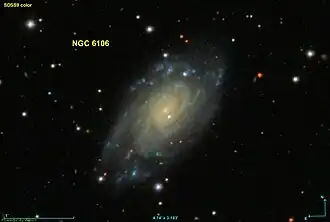NGC 6106
| NGC 6106 | |
|---|---|
 NGC 6106 imaged by SDSS | |
| Observation data (J2000 epoch) | |
| Constellation | Hercules |
| Right ascension | 16h 18m 47.1712s[1] |
| Declination | +07° 24′ 39.319″[1] |
| Redshift | 0.004833±0.000002[1] |
| Heliocentric radial velocity | 1,449±1 km/s[1] |
| Distance | 72.64 ± 2.49 Mly (22.272 ± 0.764 Mpc)[1] |
| Apparent magnitude (V) | 12.84[1] |
| Characteristics | |
| Type | SA(s)c[1] |
| Size | ~55,600 ly (17.04 kpc) (estimated)[1] |
| Apparent size (V) | 2.5′ × 1.4′[1] |
| Other designations | |
| IRAS 16163+0731, 2MASX J16184720+0724396, UGC 10328, MCG +01-41-016, PGC 57799, CGCG 052-001[1] | |
NGC 6106 is a spiral galaxy in the constellation of Hercules. Its velocity with respect to the cosmic microwave background is 1,527±6 km/s, which corresponds to a Hubble distance of 73.5 ± 5.2 Mly (22.52 ± 1.58 Mpc).[1] This is in good agreement with 29 non-redshift measurements which give an average distance of 72.64 ± 2.49 Mly (22.272 ± 0.764 Mpc).[2] It was discovered by German-British astronomer William Herschel on 13 April 1784.[3][4]
Luminous red nova and supernova
One luminous red nova and one supernova have been observed in NGC 6106:
- AT 2020kog (type LRN, mag. 20.3) was discovered by Panoramic Survey Telescope and Rapid Response System (Pan-STARRS) Search for Kilonovae on 18 May 2020.[5][6]
- SN 2024ahv (Type Ib, mag. 16.2) was discovered by Japanese astronomer Hidehiko Okoshi on 16 January 2024.[7]
See also
References
- ^ a b c d e f g h i j k "Results for object NGC 6106". NASA/IPAC Extragalactic Database. NASA and Caltech. Retrieved 13 July 2025.
- ^ "Distance Results for NGC 6106". NASA/IPAC EXTRAGALACTIC DATABASE. NASA. Retrieved 13 July 2025.
- ^ Herschel, W. (1786). "Catalogue of One Thousand New Nebulae and Clusters of Stars" (PDF). Philosophical Transactions of the Royal Society of London. 76: 457–499. Bibcode:1786RSPT...76..457H. doi:10.1098/rstl.1786.0027.
- ^ Seligman, Courtney. "New General Catalogue Objects: NGC 6106". Celestial Atlas. Retrieved 13 July 2025.
- ^ Pastorello, A.; et al. (2021). "Forbidden hugs in pandemic times. II. The luminous red nova variety: AT 2020hat and AT 2020kog". Astronomy and Astrophysics. 647: A93. arXiv:2011.10590. Bibcode:2021A&A...647A..93P. doi:10.1051/0004-6361/202039953.
- ^ "AT 2020kog". Transient Name Server. IAU. Retrieved 13 July 2025.
- ^ "SN 2024ahv". Transient Name Server. IAU. Retrieved 13 July 2025.
External links
 Media related to NGC 6106 at Wikimedia Commons
Media related to NGC 6106 at Wikimedia Commons- NGC 6106 on WikiSky: DSS2, SDSS, GALEX, IRAS, Hydrogen α, X-Ray, Astrophoto, Sky Map, Articles and images